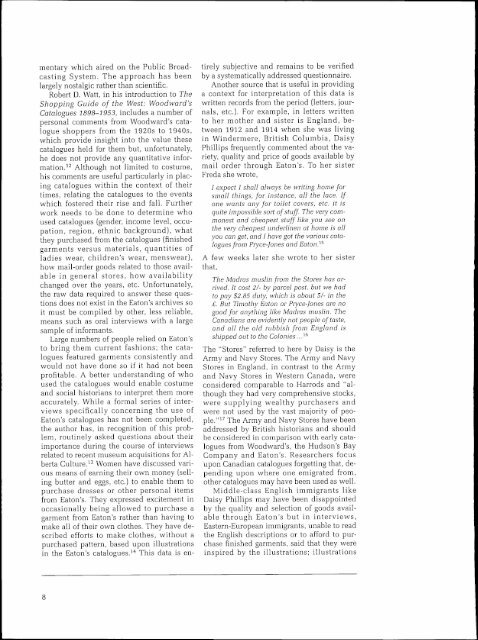Revue d'histoire de la culture materielle - Memorial University's ...
Revue d'histoire de la culture materielle - Memorial University's ...
Revue d'histoire de la culture materielle - Memorial University's ...
You also want an ePaper? Increase the reach of your titles
YUMPU automatically turns print PDFs into web optimized ePapers that Google loves.
mentary which aired on the Public Broadcasting<br />
System . The approach has been<br />
<strong>la</strong>rgely nostalgic rather than scientific .<br />
Robert D. Watt, in his introduction to The<br />
Shopping Gui<strong>de</strong> of the West : Woodward's<br />
Catalogues 1898-1953, inclu<strong>de</strong>s a number of<br />
personal comments from Woodward's catalogue<br />
shoppers from the 1920s to 1940s,<br />
which provi<strong>de</strong> insight into the value these<br />
catalogues held for them but, unfortunately,<br />
he does not provi<strong>de</strong> any quantitative information<br />
. '2 Although not limited to costume,<br />
his comments are useful particu<strong>la</strong>rly in p<strong>la</strong>cing<br />
catalogues within the context of their<br />
times, re<strong>la</strong>ting the catalogues to the events<br />
which fostered their rise and fall . Further<br />
work needs to be done to <strong>de</strong>termine who<br />
used catalogues (gen<strong>de</strong>r, income level, occupation,<br />
region, ethnic background), what<br />
they purchased from the catalogues (finished<br />
garments versus materials, quantities of<br />
<strong>la</strong>dies wear, children's wear, menswear),<br />
how mail-or<strong>de</strong>r goods re<strong>la</strong>ted to those avai<strong>la</strong>ble<br />
in general stores, how avai<strong>la</strong>bility<br />
changed over the years, etc . Unfortunately,<br />
the raw data required to answer these questions<br />
does not exist in the Eaton's archives so<br />
it must be compiled by other, less reliable,<br />
means such as oral interviews with a <strong>la</strong>rge<br />
sample of informants .<br />
Large numbers of people relied on Eaton's<br />
to bring them current fashions ; the catalogues<br />
featured garments consistently and<br />
would not have done so if it had not been<br />
profitable . A better un<strong>de</strong>rstanding of who<br />
used the catalogues would enable costume<br />
and social historians to interpret them more<br />
accurately . While a formal series of interviews<br />
specifically concerning the use of<br />
Eaton's catalogues has not been completed,<br />
the author has, in recognition of this problem,<br />
routinely asked questions about their<br />
importance during the course of interviews<br />
re<strong>la</strong>ted to recent museum acquisitions for Alberta<br />
Culture . 13 Women have discussed various<br />
means of earning their own money (selling<br />
butter and eggs, etc .) to enable them to<br />
purchase dresses or other personal items<br />
from Eaton's . They expressed excitement in<br />
occasionally being allowed to purchase a<br />
garment from Eaton's rather than having to<br />
make all of their own clothes . They have <strong>de</strong>scribed<br />
efforts to make clothes, without a<br />
purchased pattern, based upon illustrations<br />
in the Eaton's catalogues ." This data is en-<br />
8<br />
tirely subjective and remains to be verified<br />
by a systematically addressed questionnaire .<br />
Another source that is useful in providing<br />
a context for interpretation of this data is<br />
written records from the period (letters, journals,<br />
etc.) . For example, in letters written<br />
to her mother and sister is Eng<strong>la</strong>nd, between<br />
1912 and 1914 when she was living<br />
in Win<strong>de</strong>rmere, British Columbia, Daisy<br />
Phillips frequently commented about the variety,<br />
quality and price of goods avai<strong>la</strong>ble by<br />
mail or<strong>de</strong>r through Eaton's . To her sister<br />
Freda she wrote,<br />
I expect I shall always be writing home for<br />
small things, for instance, all the <strong>la</strong>ce . If<br />
one wants any for toilet covers, etc . it is<br />
quite impossible sort of stuff. The very commonest<br />
and cheapest stuff like you see on<br />
the very cheapest un<strong>de</strong>rlinen at home is all<br />
you can get, and 1 have got the various catalogues<br />
from Pryce-Jones and Eaton ."<br />
A few weeks <strong>la</strong>ter she wrote to her sister<br />
that,<br />
The Madras muslin from the Stores has arrived<br />
. It cost 2/- by parcel post. but we had<br />
to pay $2 .85 duty, which is about 5/- in the<br />
£. But Timothy Eaton or Pryce-Jones are no<br />
good for anything like Madras muslin . The<br />
Canadians are evi<strong>de</strong>ntly not people of taste,<br />
and all the old rubbish from Eng<strong>la</strong>nd is<br />
shipped out to the Colonies . . . 16<br />
The "Stores" referred to here by Daisy is the<br />
Army and Navy Stores . The Army and Navy<br />
Stores in Eng<strong>la</strong>nd, in contrast to the Army<br />
and Navy Stores in Western Canada, were<br />
consi<strong>de</strong>red comparable to Harrods and "although<br />
they had very comprehensive stocks,<br />
were supplying wealthy purchasers and<br />
were not used by the vast majority of people<br />
. "'7 The Army and Navy Stores have been<br />
addressed by British historians and should<br />
be consi<strong>de</strong>red in comparison with early catalogues<br />
from Woodward's, the Hudson's Bay<br />
Company and Eaton's . Researchers focus<br />
upon Canadian catalogues forgetting that, <strong>de</strong>pending<br />
upon where one emigrated from,<br />
other catalogues may have been used as well .<br />
Middle-c<strong>la</strong>ss English immigrants like<br />
Daisy Phillips may have been disappointed<br />
by the quality and selection of goods avai<strong>la</strong>ble<br />
through Eaton's but in interviews,<br />
Eastern-European immigrants, unable to read<br />
the English <strong>de</strong>scriptions or to afford to purchase<br />
finished garments, said that they were<br />
inspired by the illustrations ; illustrations

















